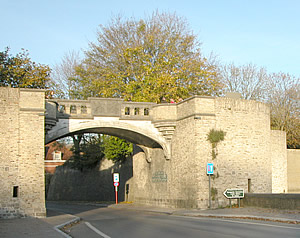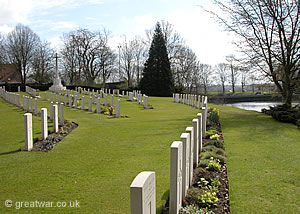The Lille Gate (Rijselpoort), Ieper/Ypres
The Lille Gate is one of several entrances into the old fortified city. The original gateway to Lille, or Rijsel as it is called in Flemish, is the only one that survived the bombardment in the First World war and so has been preserved in its historic state after numerous alterations and reconstructions over the centuries.
Origins of the Lille Gate

|
In the early days of the town's history, when it was a small settlement on the Iepere river, there were two entrances. One in the north and one in the south of the settlement. The Lille Gate is the original southern gateway.
This entrance to the city was originally called the Mesenpoort, that is, the doorway to Mesen (Messines). It also became known as the Lille Gate because the route leads to the city of Lille. Lille is also known by its Flemish name of Rijsel. Both the French and Flemish spellings of town names will be seen on signposts in this area close to the French border.
The round towers are the oldest surviving part of the stone ramparts, dating from 1385 and the Burgundian period of the city's history. The bridge over the gateway was added during later modifications to the city's fortifications.
The Lille Gate is also a water gateway. The river Ieperlee (previously known by its French name of Yprelee) springs from a lock under the western round tower and flows under the city from south to north through a vaulted waterway.
First World War Headquarters
Between 1914 and 1918 the round towers provided protection against the German artillery shells and the British Army used the towers as a location for various military units' headquarters.

|
The Lille Gate was a place in early October 1914, where many of the local people of Ypres gathered to watch the advancing German Army as it approached their city from the south. The views from here look out to the south east of the city across the battlefields of the Ypres Salient.
Imperial War Graves Commission Signs

|
On the inner wall of the gateway leading to the southern Ypres Salient, there are five of the original Imperial War Graves Commission signs for 13 British military cemeteries. These signs date back to the first formal signposting by the Commission when pilgrims began to travel to visit the battlefields after the Great War.
The Imperial War Graves Commission is now called the Commonwealth War Graves Commission. It is the agency responsible for the maintenance and care of war graves of British Forces and former Colonial and Dominion Forces buried throughout the world. See our page about the work of the Commonwealth War Graves Commission at:
Commonwealth War Graves CommissionLocation of Lille Gate, Ypres
The Lille Gate is situated in the southern edge of the town. It can be reached from the market square on foot by walking down the Rijselsstraat (about 5-10 minutes on foot). Or it can be reached by walking from the Menin Gate along the path situated on the ramparts (about 20 minutes' walk from the Menin Gate).
Related Topics
Ramparts (Lille Gate) Cemetery
Ramparts Cemetery is situated on the ramparts of the town's fortifications close to the Lille Gate. The cemetery is located in one of the most beautiful settings in the Ypres Salient.

